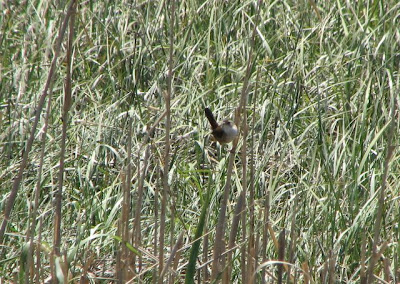Living in the northeastern U.S. has its drawbacks, specifically the relationship between spring birding and our vacation plans this year. We're sticking around through the cold, slushy early spring, patiently waiting for neotropical migrants to come to us, but right as they're arriving en mass we're heading south for a week. In an ideal birder's world you'd stay with the birds as they travel to their breeding grounds, migrating along with them. We'll be engaged in a sort of redetermined migration*, following a path differing from where we should be going, passing underneath them as they travel in the opposite direction overhead.
I'm not complaining, I swear. We decided to take an early vacation trip this year, foregoing the usual late-summer trip to Chincoteague NWR and visiting the refuge in spring. I may miss waves of warblers in Sapsucker Woods and my favorite local haunts, but I'll be gaining coastal species. And the real focus of our trip, with a couple well-timed stops in Delaware, we'll witness the Red Knot feeding frenzy as they take advantage of the Horseshoe Crab egg-laying frenzy, a phenomenon I haven't seen live and in person in a decade. Given the frightening population decline in both Horseshoe Crab and Red Knot numbers, who knows how long the spectacle will exist.
The viewing hot spot this year appears to be near Slaughter Beach at the Mispillion Harbor Reserve. We aimed to arrive at shortly after high tide, the most active time when the shorebirds are scarfing up the eggs left by the crabs. The tide schedule showed prime viewing coincided with a late lunch. That left us with time to explore Bombay Hook NWR for a couple of hours in the morning, then join the knots and other shorebirds for lunch at the DuPont Nature Center at Mispillion Inlet (we brought our own lunch, I don't find horseshoe crab eggs very filling). You don't have to chase Horseshoe Crabs and shorebirds through the woods or across fields, we figured why not set up a scope and eat sandwiches at the same time?
 A Purple Martin pair sits in the entrance of their gourd next to the
A Purple Martin pair sits in the entrance of their gourd next to theBombay Hook Visitor's Center. It's extremely rare, if not impossible,
to find martins nesting in natural cavities east of the Rockies.
Bombay Hook was, as always, worth the stop. No Eurasian vagrant, like a Little Egret or Curlew Sandpiper, to quicken the pulse, but a great place to explore nature and stretch the legs. And for a 4-year-old cooped up in a car this was paradise (both for her and us!). And there were birds, of course. We watched Purple Martins entering the gourds by the nature center, Marsh Wren songs bubbled through the phragmites and cattails, and happily we stumbled across some songbirds along the short trail to the observation tower overlooking Raymond Pool.
 Overlooking the Raymond Pool. Just in front of the trees
Overlooking the Raymond Pool. Just in front of the treesacross the pool is a smattering of shorebirds - the first birds
our four-year-old "scoped," and hopefully not the last.
American Redstarts, Common Yellowthroats, and a modest slew of other warblers decorated the trees. In a matter of minutes we identified Blue-winged, Yellow, Blackpoll, Canada, Black-throated Blue, and Chestnut-sided Warblers, along with Red-eyed Vireos, Rose-breasted Grosbeaks, and a single Yellow-billed Cuckoo.
 My camera had trouble auto-focusing on the intended subject,
My camera had trouble auto-focusing on the intended subject,so I'll market this as a nice shot of wetland vegetation.
A blurry Marsh Wren blocks the view.
Bombay Hook is known for the mudflats and water, but in those areas we didn't find too much. We were on a schedule so we only patrolled the main driving loop. We did find the expected egrets and herons, Forster's Terns, Osprey, and Dunlin. Eventually we picked out a small group of waders comprised of Short-billed Dowitchers with a few Black-necked Stilts scattered among them.
Reina was intrigued with the name Black-necked Stilt, and this time the field guide presentation wasn't satisfying her. After a lot of tripod manipulation and trial-and-error they became the first bird she ever scoped. A proud moment for Papa.
Noting the time we packed it up and headed south for the Red Knots: read more in Part II.
*Redetermined migration, as defined in a New Jersey Audubon Society article about Morning Flight (worth reading, by the way): "Movement, usually by nocturnal migrants, is typically in a direction different from (sometimes opposite) the nocturnal flight path."
-



No comments:
Post a Comment